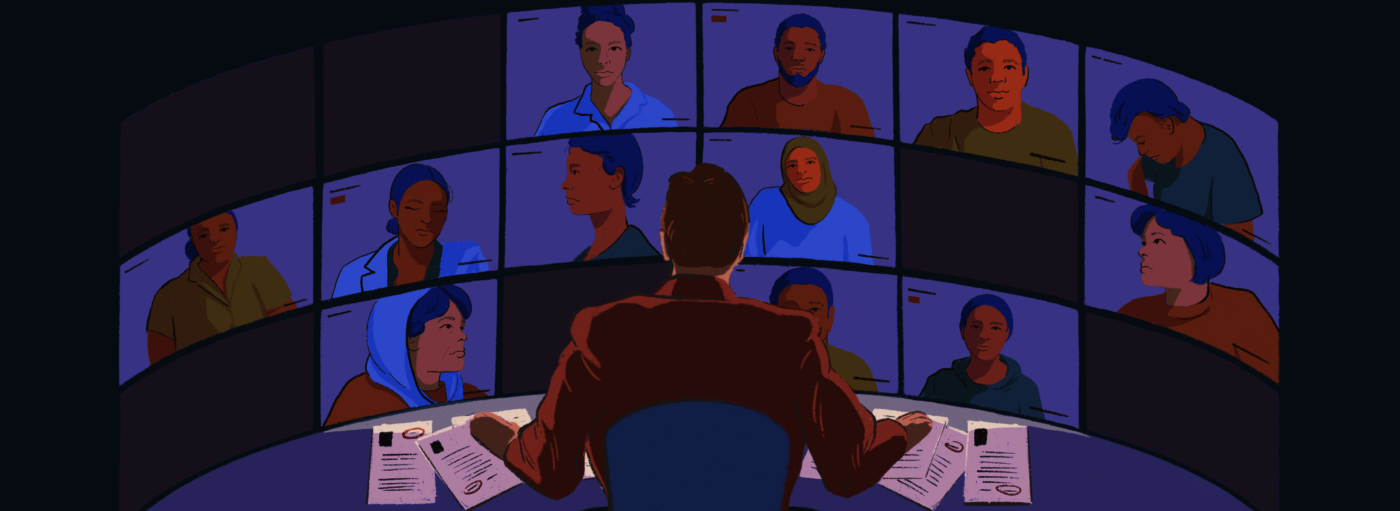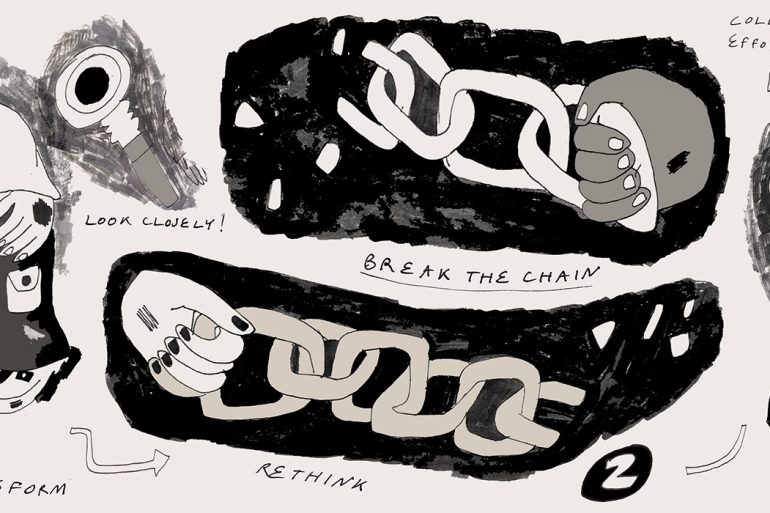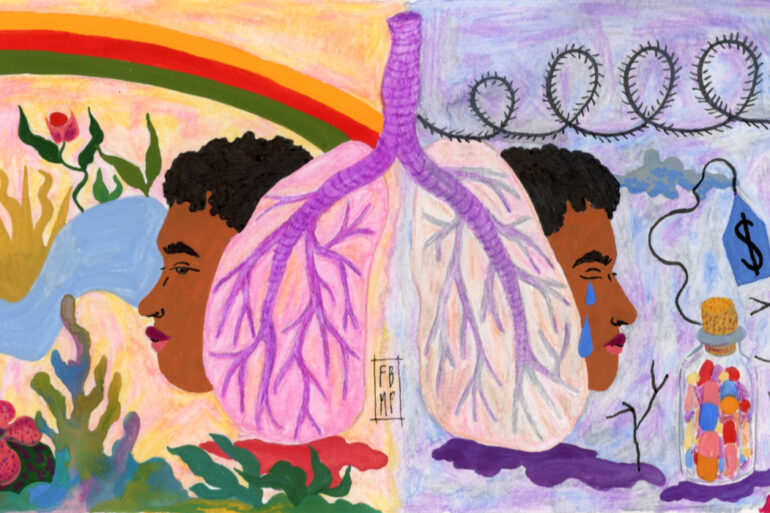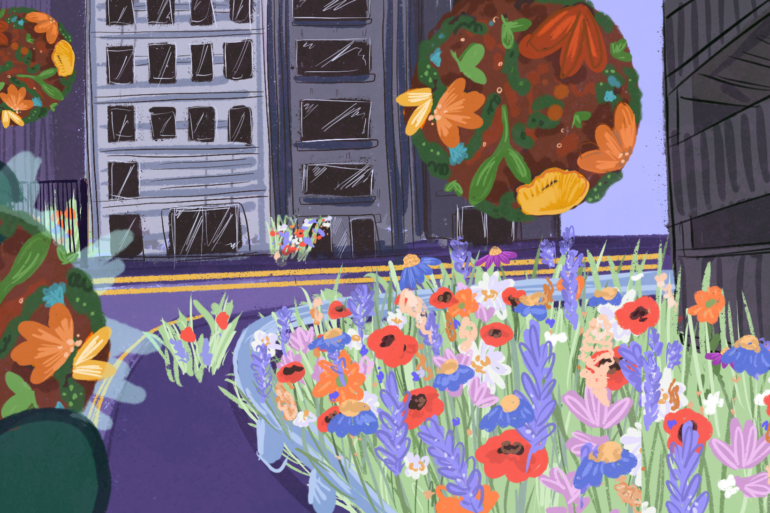What is the hostile environment?
The phrase ‘hostile environment’ describes the driving agenda behind a web of laws and policies that particularly ramped up in 2012.
These laws and policies seek to make life in the UK practically impossible for large groups of people. Put simply, the hostile environment intentionally blocks people from accessing vital services that the majority of us need to survive and thrive including: public healthcare, state education, housing and homelessness support, driving licences, social support, welfare benefits and bank accounts.
Alongside these policies which create a regime of ‘everyday borders’, the hostile environment inflicts more policing, surveillance (including through Islamophobic programmes such as ‘PREVENT’) and state violence in general upon our communities.
In addition, the use of immigration raids on homes, workers, businesses and transport hubs (what Corporate Watch describes as the government’s “basic terror tactic against migrants”); the expansion of the immigration detention and prison estate and deportation regime, and attempts to ‘offshore’ and ‘divert’ people seeking asylum to other countries continue to harass, brutalise and split up communities.
How and why was the hostile environment created? (Who does it serve)
The phrase ‘hostile environment’ was popularised in the 1990s, and was notably uttered by the Labour Immigration Minister Liam Byrne, who sought to (in his words) “flush illegal migrants out” through imposing fines for businesses who employed documented workers. Byrne also stated that “We are trying to create a much more hostile environment in this country.”
This rhetoric and approach would be reheated, plated up, and served again by the Conservative government a few decades later. When the hostile environment policy was officially ‘launched’ in 2012 by then-Home Secretary (later Prime Minister) Theresa May, she strategically used inflammatory and dehumanising language to state that, “The aim is to create, here in Britain, a really hostile environment for illegal immigrants.”
The actual function of the hostile environment is multifaceted. A primary driving force behind the hostile environment is that it fuels the scapegoating of migrant communities for issues that are in fact attributable to abysmal governance and policy decisions; suggesting (utterly fallaciously) that everyday people accessing public services is the root cause of problems within those services, and that blocking access will improve the situation.
The ‘logic’ of this idea and consequent targeting of migrant communities is incorrect as a baseline, as data shows that migrant communities are statistically less likely to access services such as the NHS and welfare benefits. This point, while true, risks slipping into dangerous notions that migrant communities ‘deserve’ to be here because migration has a net ‘benefit’ for the UK economy. We must fight to uphold the fundamental principle that everybody should have a safe and comfortable life in the place they wish to live, regardless of the salary they earn, the taxes they pay, or what support they need.
Through shouting about the need for a ‘hostile environment’, the government hopes to sweep under the rug its chronic underfunding of public services like the NHS and state schools; its failure to rebuild social housing stock after the sell-offs in the 1980s and the subsequent unavailability of quality housing, and over a decade of ‘austerity’ economic policies which slashed public spending to the bone in order to bail out bankers after the 2008 financial crash.
Relatedly, profit-making for corporates is a huge locomotive for the hostile environment. While punitive welfare policies push swathes of people into poverty, the expansion of the immigration detention and prison estates as well as the deportation regime continues to funnel public money away from vital services and into the pocket of shareholders for the private companies who manage and maintain these aspects of the border apparatus. Some of these private companies include or have included Mitie, who reported a record annual turnover last year of around £4 billion; GEO Group, who in 2018 were reporting a 30% profit margin from running Dungavel detention centre in Scotland), and Serco, who run two detention centres and a host of poor quality accommodation services for people navigating the asylum system, whose revenues increased by £109m in 2022.
How does this link to legacies of colonialism and white supremacy in the UK?
The hostile environment’s most recent iteration was introduced in 2012, jumping off from Labour policies which were gathering steam in the late 00’s.
However, this approach is part of a centuries-long trajectory which stretches back to Britain’s key role in transatlantic slavery and colonialism – a period which peaked in the 19th Century, when Britain and other European powers violently took control of and terrorised a huge chunk of the world, with long-lasting legacies into the present day.
The British state consistently hoards up wealth inside its borders for the elite slices of society through extracting resources from other countries, and labour from the international working class. It periodically ‘invites’ people to come to the UK—we saw this with the Windrush generation in the late 1940s onwards, and with the expansion of the European Union in the early 2000s, but ultimately Britain just wants people to bring their labour, and it doesn’t want people to settle down and build a life here among their families and communities.
The state doesn’t want to support communities (undocumented or otherwise), or provide any of the basic things people need to stay alive; this provides the backbone to the hostile environment approach.
Which communities are most impacted?
The hostile environment particularly targets undocumented people (people who don’t have papers or ‘leave to remain’ in the UK).
However, the far-reaching tendrils of these laws and policies target migrant communities broadly (including people in a wide range of situations who are subject to a ‘No Recourse to Public Funds’ (NRPF) condition, and are blocked from accessing state support), as well as people who are racialised and profiled as ‘non-citizens’ by state agents such as the police and border enforcement.
The hostile environment also attempts to turn everyday people into border guards, encouraging us to check and surveil our own neighbours and communities – for example by placing duties on us to check other people’s immigration status in a range of settings including healthcare, education, housing and more.
The objective of the hostile environment is to push as many people who don’t fit the state’s vision for itself into poverty and poor health. This vision that the state seeks to protect is birthed through the lens of a particularly trenchant, utterly self-flagellating, and entirely British conception of a life well-lived only through productivity and misery; such a vision is necessarily soldered to racial capitalism and white supremacy. This aspirational landscape is, so the state hopes, achieved through inflicting seismic physical and psychic violence upon communities – and keeping people in a state of economic precarity and fear of being pushed out of the country.
How has the hostile environment been legitimised by the state?
The hostile environment is framed, at different times and in different ways, through the lens of both punishment and ‘protection’. For example, most recently the government has claimed that they are conducting immigration raids in order to crack down on so-called ‘illegal working’, by which they mean workers who – in the eyes of the law – are not eligible to work in the UK because of their immigration status. These raids are framed as a protective mission – allegedly to protect the workers being raided, and at the same time to also protect people who are being – to quote the Immigration Minister – supposedly “cheated of honest work.” The use of raids here is pitched as both a (disingenuous) protective mission to ‘save’ workers from exploitation by delivering them into the hands of border guards and removing them from the country; we see similar rhetoric used in campaigns to ‘crack down’ on trafficking. At the same time, the very same raids are clearly designed to ‘crack down’ on and punish people who are working without the permission of the state, with no intention of upholding their rights as workers, which would be the surest route to reducing exploitation.
Increasingly, we have also seen feminist arguments being used to support hostile environment policies such as raids on brothels and nail bars being supported in the name of tackling ‘modern slavery’ (a concept used to push more border enforcement rather than support people) This has also included carceral feminism’s support of the use of deportation of both survivors, and people who have done harm, as a solution to domestic violence; and support for harsher prison sentences for domestic violence and rape cases. This in turn provides fuel to the expansion of prison and detention estates, and attempts to create new laws and criminal ‘offences’ and more.
We must resist the leverage of feminist arguments in support of a hostile environment which targets people who are least resourced to fight back; the hostile environment is a device of racial capitalism* (see below) and it has no place in abolitionist futures built on care and compassion.
How does the hostile environment uphold a system of racial capitalism?
The crucial context for colonialism and transatlantic slavery, the trajectories of which connect up with the hostile environment in the present day, is that of ‘racial capitalism’.
The Marxist scholar Cedric Robinson coined this ‘phrase racial’ capitalism. Robinson uses this phrase to try and explain the way that capital (wealth) – as scholar Jodi Melamed has summarised – can only grow by moving through dynamics of severe inequality between human groups.
This means that in order for elite minorities (such as bosses) to flourish under capitalism, huge chasms of economic difference must exist, enabling the exploitation of working class people for their labour. Racial capitalism is a global world order: the hostile environment takes its cue from racial capitalism by blocking access to vital services for people who face oppression along lines of race, class and more.
What can be done to resist the hostile environment?What movements are growing on the ground?
The hostile environment can and is being challenged from every single direction. Because it is a policy ‘approach’ which cuts across many areas of life and lots of different communities, workplaces and locations, lots of different individuals and groups are working hard to chip away at it from every angle.
One of the most fatal dimensions of the hostile environment is that it seeks to make life untenable by pushing people into poverty and poor health. We can push back against this by supporting people in our communities and workplaces to access services where possible and desired (e.g registering at a GP, accessing free school meals, etc).
Where people have no way of accessing these services, getting involved in and setting up mutual aid groups and collectives that can provide, for example, food, clothing, safe accommodation, leisure activities, therapeutic support and places to gather and build community are crucial ways to help people sustain themselves when they are subjected to state and border violence.
Another way to support people who are affected by the hostile environment in their workplace is to join a trade union in order to build community, share knowledge and ideas, and protect and assert our rights as workers. This can be particularly useful in sectors where there are larger numbers of people who may be undocumented. Resisting document checks, raids and racism within workplaces (both towards employees and people that businesses interact with) is an important aspect of pushing back against the hostile environment. Unions are a great place for building worker power and solidarity.
Communities can also inform themselves on how to resist the ways in which the border regime shows up in the places where we work and spend time. Anti-Raids Network is an autonomous non-centralised network of local ‘anti-raids’ groups made up of people who want to support people in their local areas to know their rights around immigration raids, and to be better equipped and informed to resist them. Similarly, Copwatch groups work across London, organising locally and training people to intervene when they see the police in their neighbourhood. Level Up is a feminist community that is also running workshops on how to support people during an immigration raid, and how to intervene as a bystander when you see the police harassing people in public spaces through ‘stop and search’.
There are also groups that work in solidarity with people in immigration detention, and people who are facing deportation or ‘removal’ from the UK. You can follow groups such as SOAS Detainee Support (SDS), and Stop Deportations on social media to find out ways to get involved and to support campaigns against border violence.
What can you do?
Read:
-
- A guide to the hostile environment: The border controls dividing our communities – and how we can bring them down by Liberty
- Against Borders: the Case for Abolition by Gracie Mae Bradley & Luke de Noronha
- Asylum for Sale: Profit and Protest in the Migration Industry Edited by Siobhán McGuirk & Adrienne Pine
- Bordering Britain: Law, race and empire by Nadine El-Enany
- Border Nation: A Story of Migration by Leah Cowan
- Hostile Environment: How immigrants became scapegoats by Maya Goodfellow
- The Truth About Modern Slavery by Emily Kenway
- The UK Border Regime: A critical guide by Corporate Watch
- What is the border industry?















